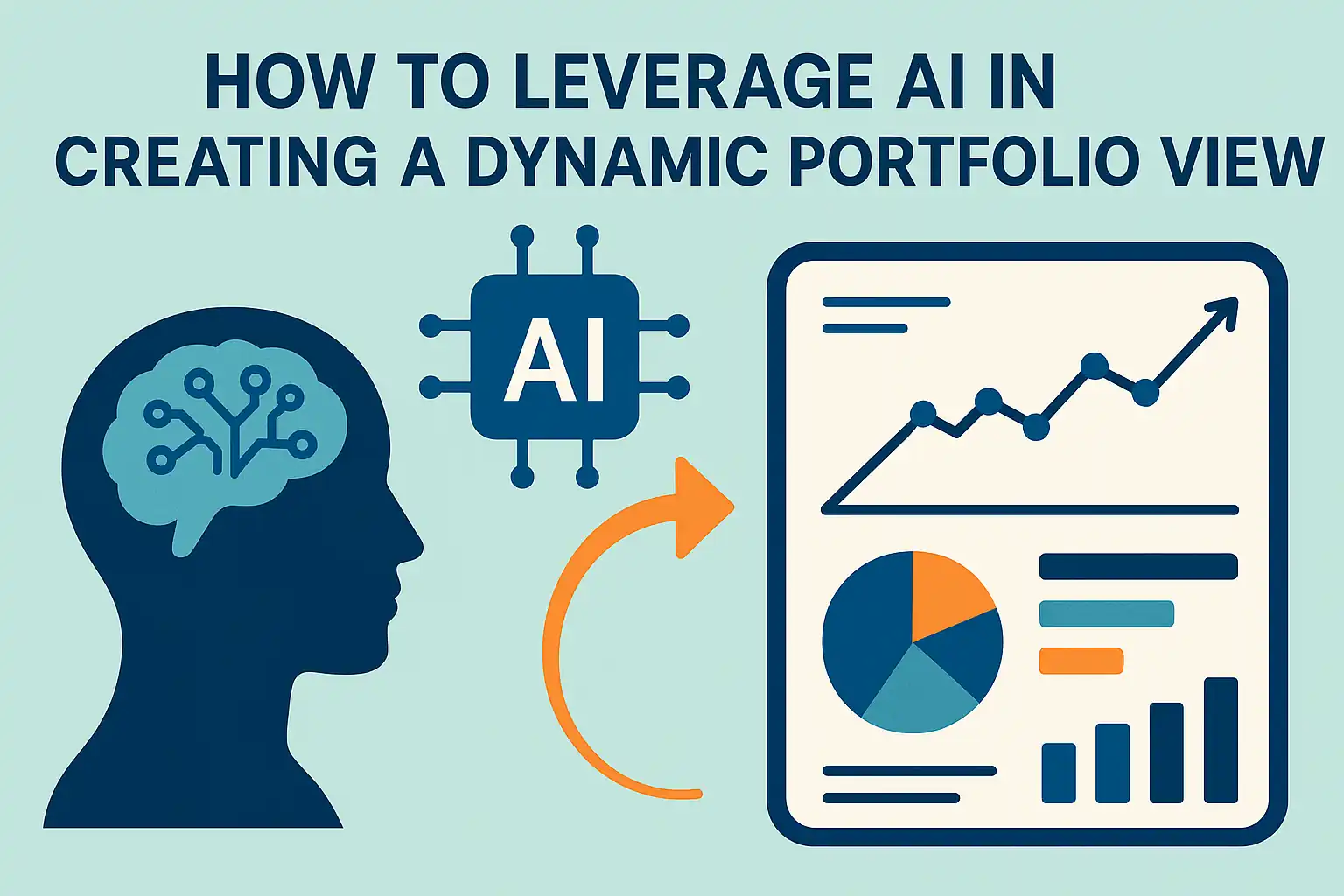Introduction to Portfolio Management and AI
Portfolio management refers to the centralized management of one or more portfolios, which are collections of projects and programs. This practice is essential for aligning projects with organizational strategy, optimizing resource allocation, and maximizing the value delivered to stakeholders. By evaluating and prioritizing projects based on their potential return on investment and strategic alignment, organizations can ensure that they are investing in the right initiatives at the right time.
A dynamic portfolio view is an innovative approach that allows project managers to visualize and manage their portfolios in real-time. Unlike traditional static views, which may only provide snapshots of project statuses at specific intervals, a dynamic portfolio view integrates data from various sources to offer a comprehensive and up-to-date perspective on project performance. This enables project managers to make informed decisions quickly, adapt to changing circumstances, and respond proactively to potential risks or opportunities.
The integration of artificial intelligence (AI) into portfolio management is becoming increasingly significant across various industries. AI technologies can analyze vast amounts of data, identify patterns, and provide insights that enhance decision-making processes. In project management, AI can automate routine tasks, predict project outcomes, and optimize resource allocation, thereby improving efficiency and effectiveness. As organizations strive to remain competitive in a rapidly evolving landscape, leveraging AI in portfolio management practices is not just an option but a necessity for tech-savvy project managers and AI enthusiasts looking to drive innovation and achieve superior results.
By embracing AI, project managers can transform their approach to portfolio management, creating a more agile and responsive environment that fosters collaboration and enhances overall project success.
Understanding the Dynamic Portfolio View
A dynamic portfolio view is an essential tool that enables project managers to visualize, analyze, and optimize their project portfolios in real-time. This approach is increasingly vital as organizations strive to remain agile and responsive to changing market conditions and project demands. Here’s a closer look at what constitutes a dynamic portfolio view, its significance, and how it contrasts with traditional portfolio views.
What Constitutes a Dynamic Portfolio View?
A dynamic portfolio view is characterized by its ability to provide a comprehensive and real-time overview of all projects within a portfolio. Key features include:
- Real-Time Data Integration: Unlike static reports, a dynamic portfolio view pulls in data from various sources continuously, ensuring that project managers have access to the most current information regarding project status, resource allocation, and performance metrics.
- Interactive Dashboards: These views often utilize interactive dashboards that allow project managers to drill down into specific projects, assess their health, and make informed decisions based on visual data representations.
- Customizable Metrics: Project managers can tailor the metrics displayed in the portfolio view to align with organizational goals, focusing on KPIs that matter most to their specific context.
Importance of Real-Time Data and Analytics in Decision-Making
The integration of real-time data and advanced analytics into the dynamic portfolio view is crucial for several reasons:
- Informed Decision-Making: Access to up-to-date information allows project managers to make timely decisions, mitigating risks and capitalizing on opportunities as they arise. For instance, if a project is falling behind schedule, managers can quickly reallocate resources or adjust timelines based on real-time insights.
- Enhanced Predictive Capabilities: AI-driven analytics can identify trends and patterns within the data, enabling project managers to forecast potential issues before they escalate. This proactive approach is essential for maintaining project alignment with strategic objectives.
- Improved Collaboration: Real-time data fosters better communication among stakeholders, as everyone has access to the same information. This transparency helps in aligning team efforts and ensuring that all members are working towards common goals.
How a Dynamic Portfolio View Differs from Traditional Portfolio Views
The shift from traditional to dynamic portfolio views represents a significant evolution in project management practices:
- Static vs. Dynamic: Traditional portfolio views often rely on periodic updates and static reports, which can quickly become outdated. In contrast, dynamic views provide continuous updates, reflecting the latest project developments and resource allocations.
- Limited vs. Comprehensive Insights: Traditional views may offer a high-level overview but lack the depth of analysis provided by dynamic views. The latter allows for granular insights into individual projects, enabling project managers to identify specific areas for improvement.
- Reactive vs. Proactive Management: With traditional portfolio views, project managers often react to issues as they arise. Dynamic portfolio views, enhanced by AI, empower managers to anticipate challenges and implement solutions proactively, leading to more successful project outcomes.
AI Technologies Transforming Portfolio Management
The integration of artificial intelligence (AI) is revolutionizing how project managers approach portfolio management. By leveraging AI technologies, project managers can enhance their decision-making processes, optimize resource allocation, and improve overall project outcomes. Here’s an overview of key AI technologies that are transforming portfolio management practices:
Overview of AI Technologies Relevant to Project Management
Machine Learning (ML):
- Machine learning algorithms can analyze historical project data to identify patterns and trends. This capability allows project managers to make data-driven decisions and predict future project performance based on past outcomes.
- ML can also facilitate the development of predictive models that help in forecasting project timelines and budgets, thereby enhancing the accuracy of project planning.
Natural Language Processing (NLP):
- NLP enables the analysis of unstructured data, such as project documentation, emails, and meeting notes. By extracting relevant information and insights, NLP can help project managers stay informed about project status and stakeholder sentiments.
- This technology can also automate the generation of reports and summaries, saving time and reducing the risk of human error.
Predictive Analytics:
- Predictive analytics utilizes statistical algorithms and machine learning techniques to analyze current and historical data. This allows project managers to forecast potential risks and opportunities within their portfolios.
- By identifying trends and anomalies, predictive analytics can inform strategic decision-making, enabling project managers to proactively address issues before they escalate.
Automating Data Collection and Processing
AI technologies can significantly streamline the data collection and processing phases of portfolio management. Here’s how:
- Automated Data Integration: AI can facilitate the integration of data from various sources, such as project management tools, financial systems, and resource management platforms. This automation reduces the manual effort required to gather and consolidate data, allowing project managers to focus on analysis and strategy.
- Real-Time Data Processing: With AI, project managers can access real-time data analytics, enabling them to monitor project performance continuously. This capability allows for timely adjustments to project plans and resource allocations based on the latest information.
- Enhanced Reporting: AI-driven tools can automatically generate comprehensive reports that highlight key performance indicators (KPIs), project health, and resource utilization. This not only saves time but also ensures that stakeholders receive accurate and up-to-date information.
Role of AI in Risk Assessment and Resource Allocation
AI plays a crucial role in enhancing risk assessment and resource allocation within portfolio management:
- Risk Identification and Mitigation: AI algorithms can analyze historical project data to identify potential risks and their likelihood of occurrence. By assessing various risk factors, project managers can develop mitigation strategies tailored to specific projects within the portfolio.
- Optimized Resource Allocation: AI can assist in determining the optimal allocation of resources across multiple projects. By analyzing project requirements, team capabilities, and availability, AI can recommend the best distribution of resources to maximize efficiency and minimize bottlenecks.
- Scenario Analysis: AI technologies enable project managers to conduct scenario analyses, allowing them to evaluate the impact of different decisions on project outcomes. This capability supports informed decision-making and enhances the ability to adapt to changing project dynamics.
Innovative Applications of AI in Creating a Dynamic Portfolio View
Leveraging artificial intelligence (AI) can significantly enhance portfolio management practices. By integrating AI technologies, project managers can create a dynamic portfolio view that not only improves visibility but also supports informed decision-making. Here are some innovative applications of AI in portfolio management, along with practical examples and insights.
Real-Time Analytics and Dashboards Powered by AI for Enhanced Visibility
AI technologies enable the creation of real-time analytics and dashboards that provide project managers with immediate insights into portfolio performance. Key features include:
- Predictive Analytics: AI algorithms can analyze vast amounts of data to forecast project risks and outcomes. This allows project managers to proactively address potential issues before they escalate.
- Customizable Dashboards: AI-powered dashboards can be tailored to display key performance indicators (KPIs) relevant to specific projects or portfolios. This customization ensures that project managers have access to the most pertinent information at their fingertips.
- Automated Reporting: AI can automate the generation of reports, saving time and reducing the likelihood of human error. This feature allows project managers to focus on strategic decision-making rather than data compilation.
By utilizing real-time analytics and dashboards, project managers can enhance visibility across their portfolios, leading to more informed and timely decisions.
AI-Driven Decision Support Systems for Portfolio Performance Recommendations
AI-driven decision support systems (DSS) are revolutionizing how project managers approach portfolio management. These systems provide actionable recommendations based on comprehensive data analysis. Key benefits include:
- Performance Optimization: AI can analyze project performance metrics and suggest adjustments to improve efficiency. For example, if a project is falling behind schedule, the AI system might recommend reallocating resources or adjusting timelines.
- Scenario Analysis: AI DSS can simulate various scenarios based on different project parameters, helping managers understand the potential impact of their decisions. This capability allows for more strategic planning and risk management.
- Resource Allocation: AI can optimize resource allocation across multiple projects by analyzing workload, skill sets, and project timelines. This ensures that resources are utilized effectively, minimizing waste and maximizing productivity.
By integrating AI-driven decision support systems, project managers can enhance their ability to make data-informed decisions that drive portfolio success.
Challenges and Considerations in AI Implementation
Integrating artificial intelligence (AI) into portfolio management can significantly enhance project management practices, but it also presents several challenges and considerations that project managers must address. Here are some key points to consider:
1. Data Privacy and Security Concerns
- Sensitive Information: AI systems often require access to large volumes of data, which may include sensitive project information. Project managers must ensure that data privacy regulations, such as GDPR or HIPAA, are adhered to when implementing AI solutions. This involves establishing robust data governance frameworks to protect sensitive information from unauthorized access and breaches.
- Cybersecurity Risks: The integration of AI can introduce new vulnerabilities. Project managers should assess the cybersecurity measures in place to protect AI systems from potential threats, ensuring that data integrity and confidentiality are maintained throughout the project lifecycle.
2. Importance of Change Management and Staff Training
- Cultural Shift: Implementing AI in portfolio management often necessitates a cultural shift within the organization. Project managers should prepare for resistance to change by fostering a culture that embraces innovation and technology. This can be achieved through clear communication about the benefits of AI and how it can enhance existing processes.
- Training and Development: Staff training is crucial for successful AI integration. Project managers should invest in training programs that equip team members with the necessary skills to work alongside AI tools. This includes understanding how to interpret AI-generated insights and making informed decisions based on those insights. Continuous learning opportunities can help staff adapt to evolving technologies and maintain a competitive edge.
3. Limitations of AI and the Need for Human Oversight
- AI Limitations: While AI can analyze vast amounts of data and identify patterns, it is not infallible. Project managers should be aware of the limitations of AI, such as its inability to understand context or make nuanced decisions that require human judgment. Relying solely on AI for critical decision-making can lead to oversights and errors.
- Human Oversight: To mitigate the risks associated with AI limitations, human oversight is essential. Project managers should establish processes for reviewing AI recommendations and ensuring that human expertise informs final decisions. This collaborative approach can enhance the effectiveness of AI tools while maintaining accountability and quality in project management practices.
By addressing these challenges and considerations, project managers can effectively leverage AI to create a dynamic portfolio view that enhances decision-making and drives project success. Balancing the benefits of AI with the need for data security, change management, and human oversight will be key to successful implementation.
Future Trends: AI and the Evolution of Portfolio Management
The integration of artificial intelligence (AI) is set to redefine how project managers approach portfolio management. This section explores emerging trends in AI that could significantly impact portfolio management practices, enhance collaboration within project teams, and outline the future skills necessary for project managers in an AI-driven landscape.
Emerging Trends in AI Affecting Portfolio Management
- Predictive Analytics: AI-driven predictive analytics tools are becoming increasingly sophisticated, allowing project managers to forecast project outcomes with greater accuracy. By analyzing historical data and current project metrics, these tools can identify potential risks and opportunities, enabling proactive decision-making. This trend will empower project managers to optimize resource allocation and prioritize projects that align with strategic goals.
- Automated Reporting: The automation of reporting processes through AI can save project managers significant time and effort. AI can generate real-time reports that provide insights into project performance, resource utilization, and budget adherence. This shift towards automated reporting not only enhances efficiency but also allows project managers to focus on strategic planning and stakeholder engagement.
- Enhanced Decision-Making: AI can assist project managers in making data-driven decisions by providing insights derived from vast amounts of data. Machine learning algorithms can analyze patterns and trends, offering recommendations that help project managers choose the best course of action. This capability is particularly valuable in portfolio management, where decisions must consider multiple projects and their interdependencies.
Enhancing Collaboration and Communication
- AI-Powered Collaboration Tools: The rise of AI-powered collaboration platforms is transforming how project teams communicate and work together. These tools can facilitate real-time collaboration, streamline communication, and ensure that all team members are aligned on project goals. Features such as intelligent chatbots can assist in answering queries, scheduling meetings, and providing updates, thereby enhancing team productivity.
- Sentiment Analysis: AI can analyze team communications to gauge sentiment and morale, providing project managers with insights into team dynamics. Understanding team sentiment can help project managers address issues before they escalate, fostering a more collaborative and positive work environment.
- Virtual Assistants: The use of AI-driven virtual assistants can enhance communication by managing routine tasks such as scheduling, reminders, and follow-ups. This allows project managers to focus on higher-level strategic activities while ensuring that team members remain informed and engaged.
Future Skills for Project Managers in an AI-Driven Landscape
- Data Literacy: As AI tools become integral to portfolio management, project managers will need to develop strong data literacy skills. Understanding how to interpret data insights and leverage them for decision-making will be crucial in an AI-enhanced environment.
- Adaptability: The rapid pace of technological change necessitates that project managers remain adaptable. Embracing new AI tools and methodologies will be essential for staying competitive and effectively managing portfolios in a dynamic landscape.
- Collaboration and Leadership: With AI facilitating enhanced collaboration, project managers will need to focus on developing their leadership skills. The ability to inspire and motivate teams, foster collaboration, and navigate complex interpersonal dynamics will be vital as project teams become more diverse and distributed.
- Strategic Thinking: As AI takes on more operational tasks, project managers will need to shift their focus towards strategic thinking. This includes understanding how to align projects with organizational goals, assess the impact of AI on project outcomes, and make informed decisions that drive value.
Conclusion
In the ever-evolving landscape of project management, maintaining a dynamic portfolio view is crucial for ensuring that organizations can adapt to changing circumstances and make informed decisions. A dynamic portfolio view allows project managers to visualize the status of multiple projects simultaneously, assess resource allocation, and prioritize initiatives based on strategic goals. This holistic perspective is essential for optimizing performance and achieving desired outcomes.
Artificial intelligence (AI) plays a transformative role in enhancing portfolio management practices. By leveraging AI technologies, project managers can:
- Automate Data Analysis: AI can process vast amounts of data quickly, providing insights that would be time-consuming for humans to gather. This enables project managers to make data-driven decisions with greater accuracy and speed.
- Predictive Analytics: AI algorithms can analyze historical project data to forecast potential risks and outcomes. This predictive capability allows project managers to proactively address issues before they escalate, ensuring smoother project execution.
- Resource Optimization: AI can help identify the best allocation of resources across projects, ensuring that teams are utilized effectively and that projects are aligned with organizational priorities.
- Enhanced Reporting: With AI, project managers can generate real-time reports that reflect the current status of the portfolio, making it easier to communicate progress to stakeholders and adjust strategies as needed.
As project management continues to embrace technological advancements, it is essential for tech-savvy project managers and AI enthusiasts to explore the various AI tools and technologies available for portfolio management. By integrating AI into their practices, they can create a more dynamic and responsive portfolio view that not only enhances efficiency but also drives innovation and success in their projects.
In summary, the integration of AI into portfolio management is not just a trend; it is a strategic necessity that empowers project managers to navigate complexities with confidence and agility. Embracing these innovative solutions will undoubtedly lead to improved project outcomes and a more resilient organizational framework.
Find out more about Shaun Stoltz https://www.shaunstoltz.com/about/.
This post was written by an AI and reviewed/edited by a human.



